Aggregated Risk Assessment and Survey for Risk Reduction in Oil Terminals
Abstract
:1. Introduction
2. Materials and Methods
2.1. Hazard Identification Procedure
2.2. Likelihood Assessment
2.3. Consequences Assessment
2.4. Risk Calculation and Aggregation Approach
- Contours of “Location-Specific Individual Risk” (LSIR) are used to estimate injury and fatality risk. They are schematic IR reflections that represent the levels of risk at specific location points to provide so-called iso-risk contours. They are given on a risk-related graphic indicating the range of risk values for the considered place.
- Societal risk “F-N Curve” is also given as a graphical representation and is a “societal risk” measure. It reflects the possibility for various hazards or incidents to cause fatalities at different locations by plotting the estimate of probability, i.e., present “N or more fatalities” frequency (F) against the fatalities’ number (N).
- Exact location;
- Timing and number of people present; and
- Information about building types and persons located indoors.
2.5. Risk Criteria and Evaluation
- Unacceptable, defined above the “unacceptable” risk-level or margin, where the total risk is considered as too high, even if there is no issue meeting IR criteria;
- “As low as reasonably practicable” (ALARP) level, the zone in which the activities should reduce the risk as far as practical for the minimal or “negligible” risk level (for instance, demonstrating that risk is reasonably decreased to a level as low as practicable); and
- Broadly acceptable, meaning that it is below the “broadly acceptable” risk zone which reflects that the societal risk is considered as insignificant, while all individual risk criteria are met as well.
3. Case Study and Results
3.1. Brief Description of the KN Oil Terminal
3.2. Identification of Hazards at the KN Oil Terminal
- Identification of hazards posed by hazardous materials stored at the KN terminal;
- Initial analysis of the consequences/determination of the possible impact zones with the maximum amount of hazardous substance spillage;
- Assessment of the hazardousness of the substances and evaluation of their consequences in the initial analysis (to distinguish the most hazardous substance);
- Combining similar initial events and identifying the most dangerous material for the quantitative analysis; and
- Quantitative risk assessment for the selected hazardous substance scenarios.
3.3. Hazardous Scenario Development
- The most adverse meteorological conditions (wind speed of 1 m/s) are accepted;
- The instantaneous spill of the substance is kept in the storage tank;
- The vaporization time until the spray surface is covered with foam is defined as 1 h (3600 s);
- The influence of the wind direction is not considered to obtain the thermal impact zone of a fire and fireball;
- An explosion is possible anywhere in the area where a hazardous concentration is reached;
- The explosive (flammable) mixtures can be formed by all stored materials; and
- IDLH (immediately dangerous to life or health) concentrations and relevant exceedance areas are calculated using a model for heavy gas dispersion.
3.4. Assessment Results Interpretation
- LSIR contours, i.e., an estimate of the individual risk; and
- The F-N curve as an estimate of the societal risk.
3.5. Practical Actions and Recommendations
4. Conclusions
Author Contributions
Funding
Institutional Review Board Statement
Informed Consent Statement
Data Availability Statement
Conflicts of Interest
Abbreviations
| AICE | American Institute of Chemical Engineers |
| AIRM | aggregated individual risk measure |
| ALARP | as low as reasonably practicable |
| ARI | aggregate risk index |
| IR | individual risk |
| IRC | individual risk contour |
| IRPA | individual risk per annum |
| EU | European Union |
| HAZID | HAZard IDentification Study |
| HAZMAT | HAZardous MATerial |
| HAZOP | HAZard and OPerability Study |
| KN | Klaipedos Nafta AB |
| LNG | liquefied natural gas |
| LSIR | location-specific individual risk |
| ROD | rate of death |
| QRA | quantitative risk assessment |
References
- EU. Directive Directive 2012/18/EU of the European Parliament and of the Council of 4 July 2012 on the Control of Major-Accident Hazards Involving Dangerous Substances, Amending and Subsequently Repealing Council Directive 96/82/EC. Off. J. Eur. Union 2012, 55, 1–37. [Google Scholar]
- Zio, E.; Pedroni, N. Overview of Risk-Informed Decision-Making Processes; Foundation for an Industrial Safety Culture: Toulouse, France, 2012; ISBN 21003874. [Google Scholar]
- Christou, M.D.; Mattarelli, M. Land-use planning in the vicinity of chemical sites: Risk-informed decision making at a local community level. J. Hazard. Mater. 2000, 78, 191–222. [Google Scholar] [CrossRef]
- Khakzad, N. Which Fire to Extinguish First? A Risk-Informed Approach to Emergency Response in Oil Terminals. Risk Anal. 2017, 38, 1444–1454. [Google Scholar] [CrossRef] [Green Version]
- Shebeko, Y.; Bolodian, I.; Molchanov, V.; Deshevih, Y.; Gordienko, D.; Smolin, I.; Kirillov, D. Fire and explosion risk assessment for large-scale oil export terminal. J. Loss Prev. Process. Ind. 2007, 20, 651–658. [Google Scholar] [CrossRef]
- Aneziris, O.; Papazoglou, I.; Konstantinidou, M.; Nivolianitou, Z. Integrated risk assessment for LNG terminals. J. Loss Prev. Process. Ind. 2014, 28, 23–35. [Google Scholar] [CrossRef]
- Fu, S.; Yan, X.; Zhang, D.; Li, C.; Zio, E. Framework for the quantitative assessment of the risk of leakage from LNG-fueled vessels by an event tree-CFD. J. Loss Prev. Process. Ind. 2016, 43, 42–52. [Google Scholar] [CrossRef] [Green Version]
- Kang, J.; Liang, W.; Zhang, L.; Lu, Z.; Liu, D.; Yin, W.; Zhang, G. A new risk evaluation method for oil storage tank zones based on the theory of two types of hazards. J. Loss Prev. Process. Ind. 2014, 29, 267–276. [Google Scholar] [CrossRef]
- CMPT. A Guide to Quantitative Risk Assessment for Offshore Installations; the Centre for Marine and Petroleum Technology; DNV Technica: Oslo, Norway, 1999; ISBN 978-1-870553-36-0. [Google Scholar]
- Eades, M. Approaches to Hazard Identification; Health and Safety Executive; Health & Safety Executive: Sheffield, UK, 1998.
- Wadhwani, R.; Kumar, V.; Singh, P. Hazards on Offshore Platform: A Review. In Proceedings of the Chemcon, Manjusar, India, 27 December 2012. [Google Scholar]
- Chang, J.I.; Lin, C.-C. A study of storage tank accidents. J. Loss Prev. Process. Ind. 2006, 19, 51–59. [Google Scholar] [CrossRef]
- Fuentes-Bargues, J.L.; González-Cruz, M.C.; González-Gaya, C.; Baixauli-Pérez, M.P. Risk Analysis of a Fuel Storage Terminal Using HAZOP and FTA. Int. J. Environ. Res. Public Health 2017, 14, 705. [Google Scholar] [CrossRef] [PubMed]
- Marhavilas, P.K.; Filippidis, M.; Koulinas, G.K.; Koulouriotis, D.E. A HAZOP with MCDM Based Risk-Assessment Approach: Focusing on the Deviations with Economic/Health/Environmental Impacts in a Process Industry. Sustainability 2020, 12, 993. [Google Scholar] [CrossRef] [Green Version]
- Wu, J.; Lind, M. Management of System Complexity in HAZOP for the Oil &Gas Industry. IFAC PapersOnLine 2018, 51, 211–216. [Google Scholar] [CrossRef]
- Romero-Faz, D.; Camarero-Orive, A. Risk assessment of critical infrastructures—New parameters for commercial ports. Int. J. Crit. Infrastruct. Prot. 2017, 18, 50–57. [Google Scholar] [CrossRef]
- Jaradat, R.M.; Keating, C.B. Fragility of oil as a critical infrastructure problem. Int. J. Crit. Infrastruct. Prot. 2014, 7, 86–99. [Google Scholar] [CrossRef]
- Zohuri, B.; Fathi, N. Thermal-Hydraulic Analysis of Nuclear Reactors; Springer International Publishing: New York, NY, USA, 2015; ISBN 9783319174334. [Google Scholar]
- Carter, G.; Smith, S.D. Safety Hazard Identification on Construction Projects. J. Constr. Eng. Manag. 2006, 132, 197–205. [Google Scholar] [CrossRef]
- Centar for Chemical Process. Safety. Guidelines for Hazard Evaluation Procedures; Wiley: Hoboken, NJ, USA, 2011; ISBN 9781118211663. [Google Scholar]
- Naciri, M.; Poldervaart, L. Design Aspects of SPM LNG Terminals in Shallow Water. In Proceedings of the Offshore Technology Conference, Houston, TX, USA, 3–6 May 2004. [Google Scholar] [CrossRef]
- Stackhouse, M.R.D.; Stewart, R. Failing to Fix What is Found: Risk Accommodation in the Oil and Gas Industry. Risk Anal. 2016, 37, 130–146. [Google Scholar] [CrossRef] [PubMed]
- Landucci, G.; Argenti, F.; Cozzani, V.; Reniers, G. Assessment of attack likelihood to support security risk assessment studies for chemical facilities. Process. Saf. Environ. Prot. 2017, 110, 102–114. [Google Scholar] [CrossRef]
- International Association of Oil and Gas Producers. Risk Assessment Data Directory—Process Release Frequencies; Report 434-01; International Association of Oil and Gas Producers: London, UK, 2010. [Google Scholar]
- International Association of Oil and Gas Producers. Risk Assessment Data Directory—Storage Incident Frequencies; Report 434-03; International Association of Oil and Gas Producers: London, UK, 2010. [Google Scholar]
- International Association of Oil and Gas Producers. Risk Assessment Data Directory—Riser and Pipeline Release Frequencies; Report 434-04; International Association of Oil and Gas Producers: London, UK, 2010. [Google Scholar]
- International Association of Oil and Gas Producers. Risk Assessment Data Directory—Ignition Probabilities; Report 434-06; International Association of Oil and Gas Producers: London, UK, 2010. [Google Scholar]
- Committee for the Prevention of Disasters. Guidelines for Quantitative Risk Assessment: Purple Book; Committee for the Prevention of Disasters: The Hague, The Netherlands, 1999; ISBN 9789012087964. [Google Scholar]
- Health and Safety Executive. Failure Rate and Event Data for Use within Land Use Planning Risk Assessment; UK Health and Safety Executive: Bootle, UK, 2010.
- Pintarič, Z. Assessment of the Consequences of Accident Scenarios Involving Dangerous Substances. Process. Saf. Environ. Prot. 2007, 85, 23–38. [Google Scholar] [CrossRef]
- Cirimello, P.; Otegui, J.L.; Ramajo, D.; Carfi, G. A major leak in a crude oil tank: Predictable and unexpected root causes. Eng. Fail. Anal. 2019, 100, 456–469. [Google Scholar] [CrossRef]
- Center for Chemical Process Safety. Guidelines for Chemical Process Quantitative Risk Analysis; John Wiley & Sons: Hoboken, NJ, USA, 1989; ISBN 978081690400. [Google Scholar]
- De Silva, K.; Gunasekera, M.; De Alwis, A. Derivation of a societal risk acceptance criterion for major accident hazard installations in Sri Lanka. Process. Saf. Environ. Prot. 2017, 111, 388–398. [Google Scholar] [CrossRef]
- Sarewitz, D.; Pielke, R.; Keykhah, M. Vulnerability and risk: Some thoughts from a political and policy perspective. Risk Anal. 2003, 23, 805–810. [Google Scholar] [CrossRef] [PubMed] [Green Version]
- Aven, T. Misconceptions of Risk; John Wiley & Sons Ltd.: Chichester, UK, 2010; ISBN 9780470686539. [Google Scholar]
- Center for Chemical Process Safety. Guidelines for Evaluating Process Plant Buildings for External Explosions and Fires; John Wiley & Sons Ltd.: Chichester, UK, 1996; ISBN 9780816906468. [Google Scholar]
- Center for Chemical Process Safety. Layer of Protection Analysis: Simplified Process Risk Assessment; John Wiley & Sons, Inc.: Hoboken, NJ, USA, 2010; ISBN 9780470935590. [Google Scholar]
- Crowl, D.A. Understanding Explosions, 1st ed.; American Institute of Chemical Engineers: New York, NY, USA, 2003; ISBN 9780816907793. [Google Scholar]
- Mannan, S. Lees’ Loss Prevention in the Process Industries: Hazard Identification, Assessment and Control; Elsevier: Oxford, UK, 2012; ISBN 9780123971890. [Google Scholar]

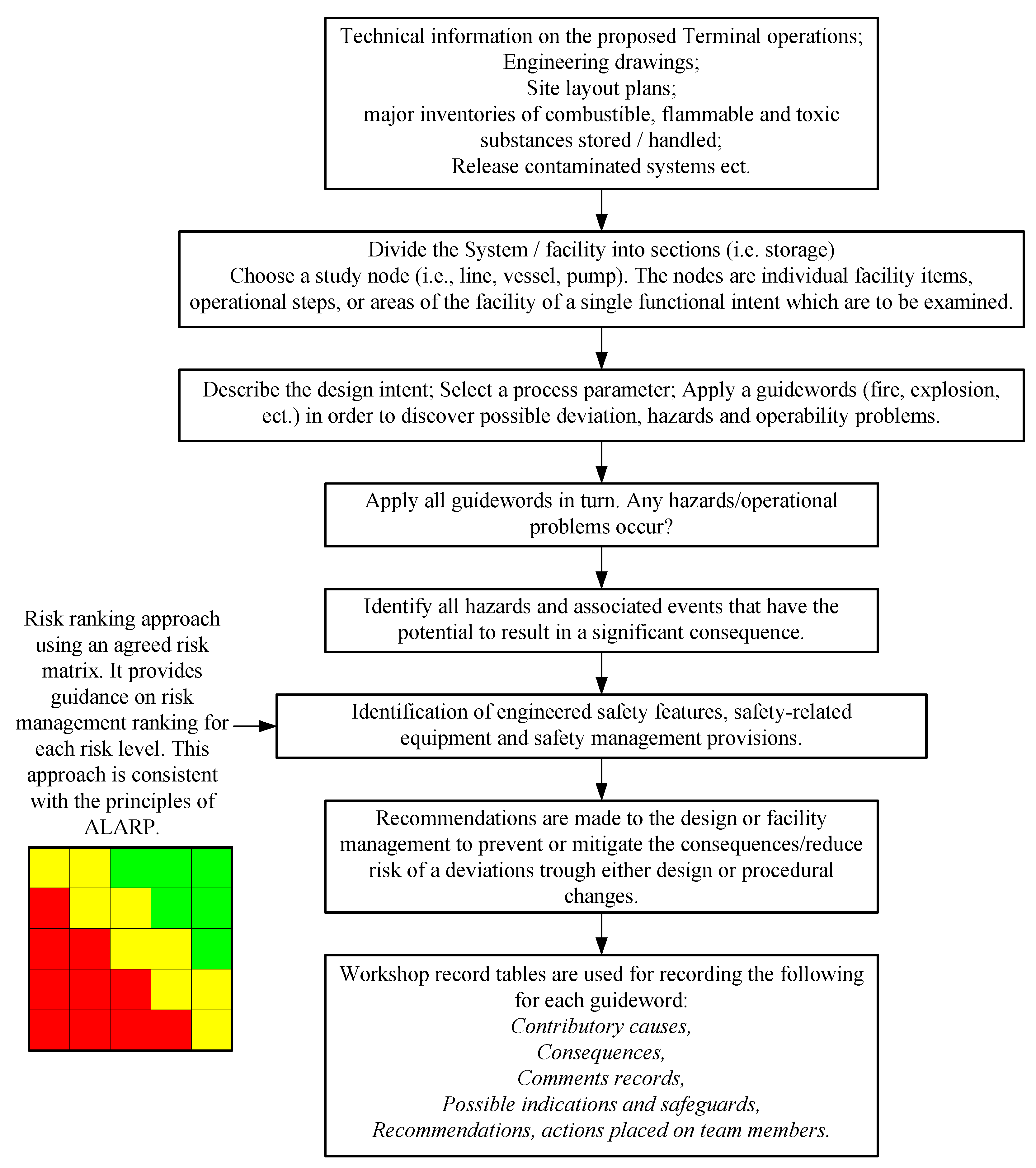
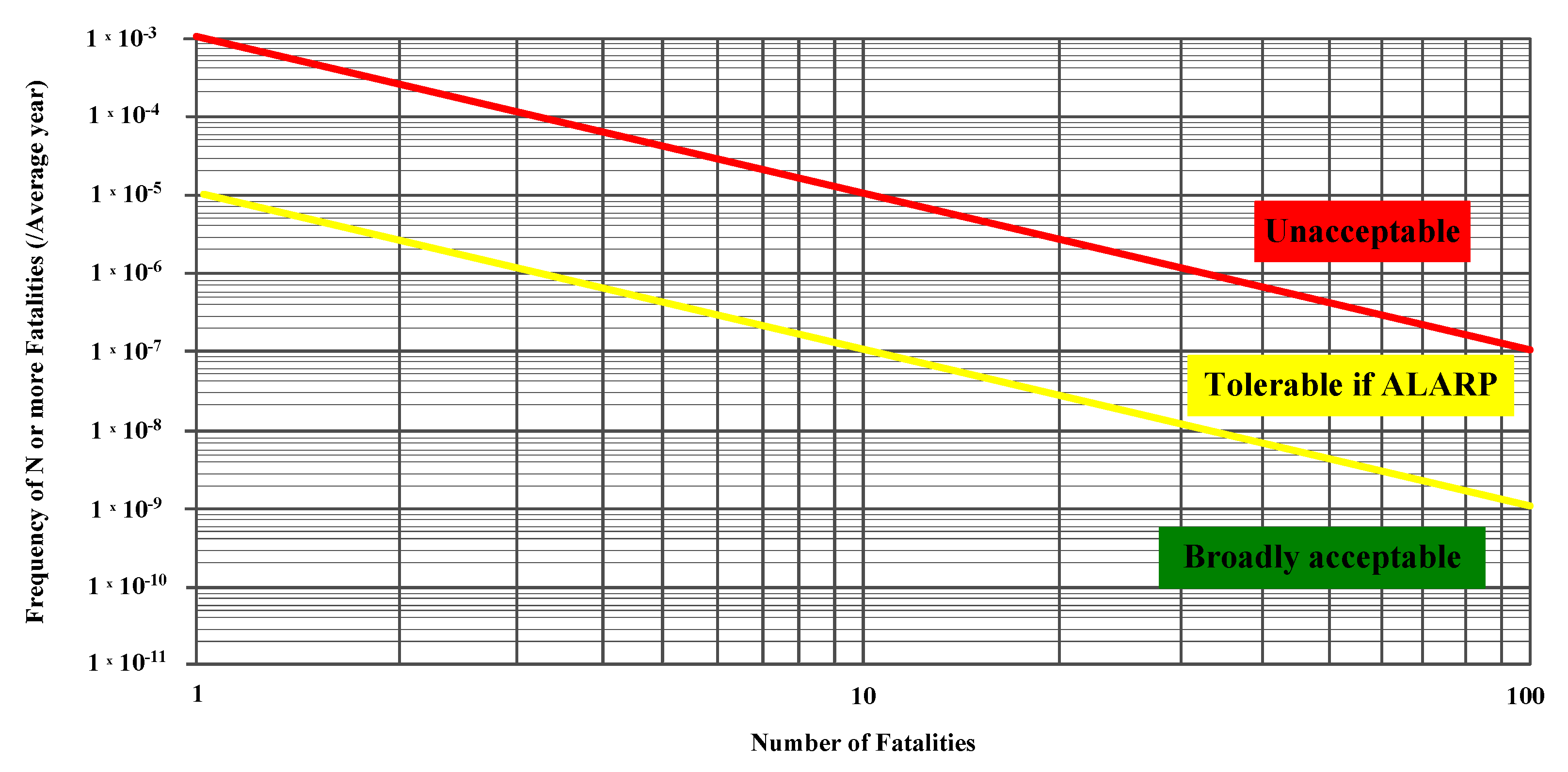
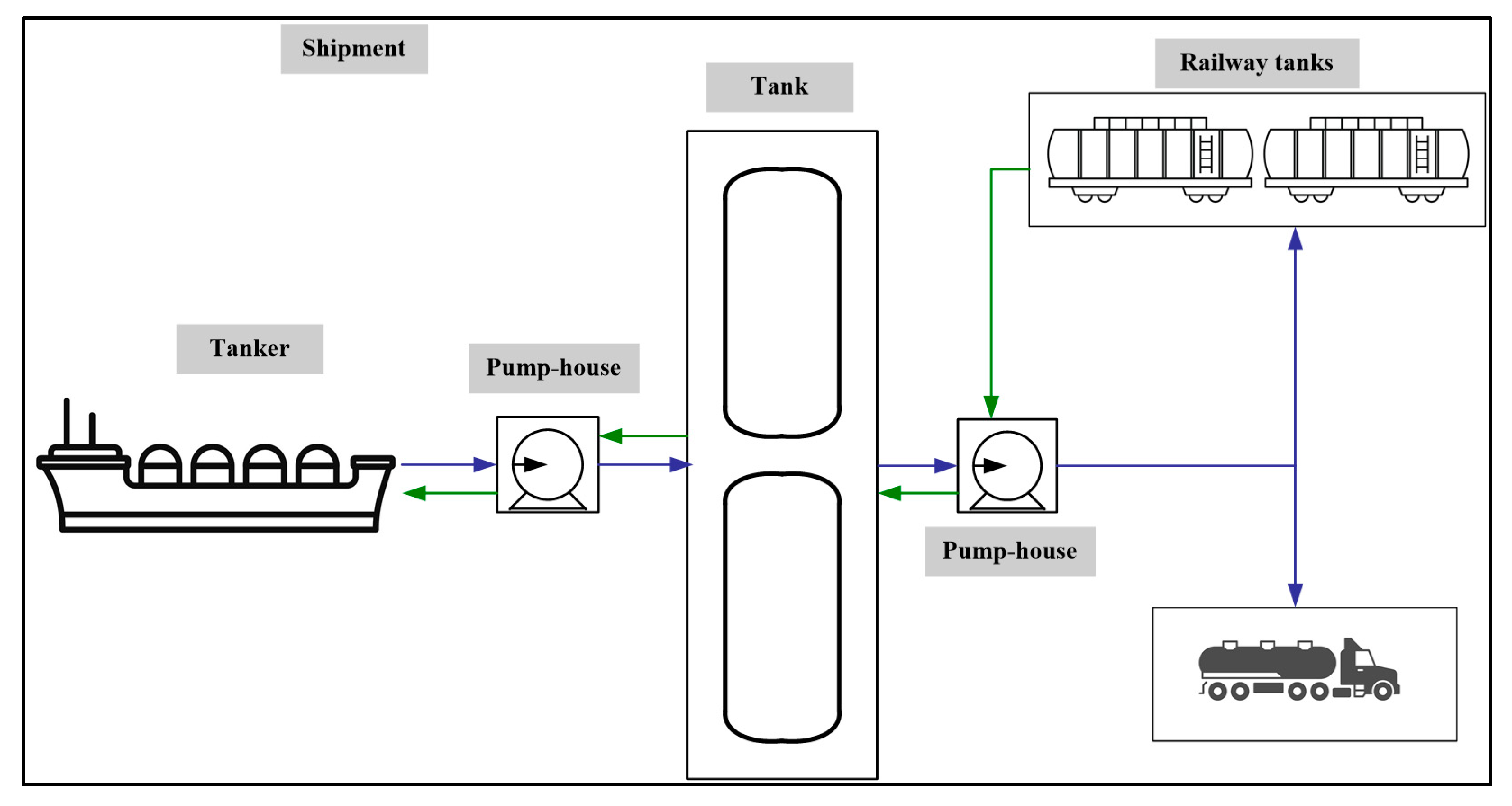

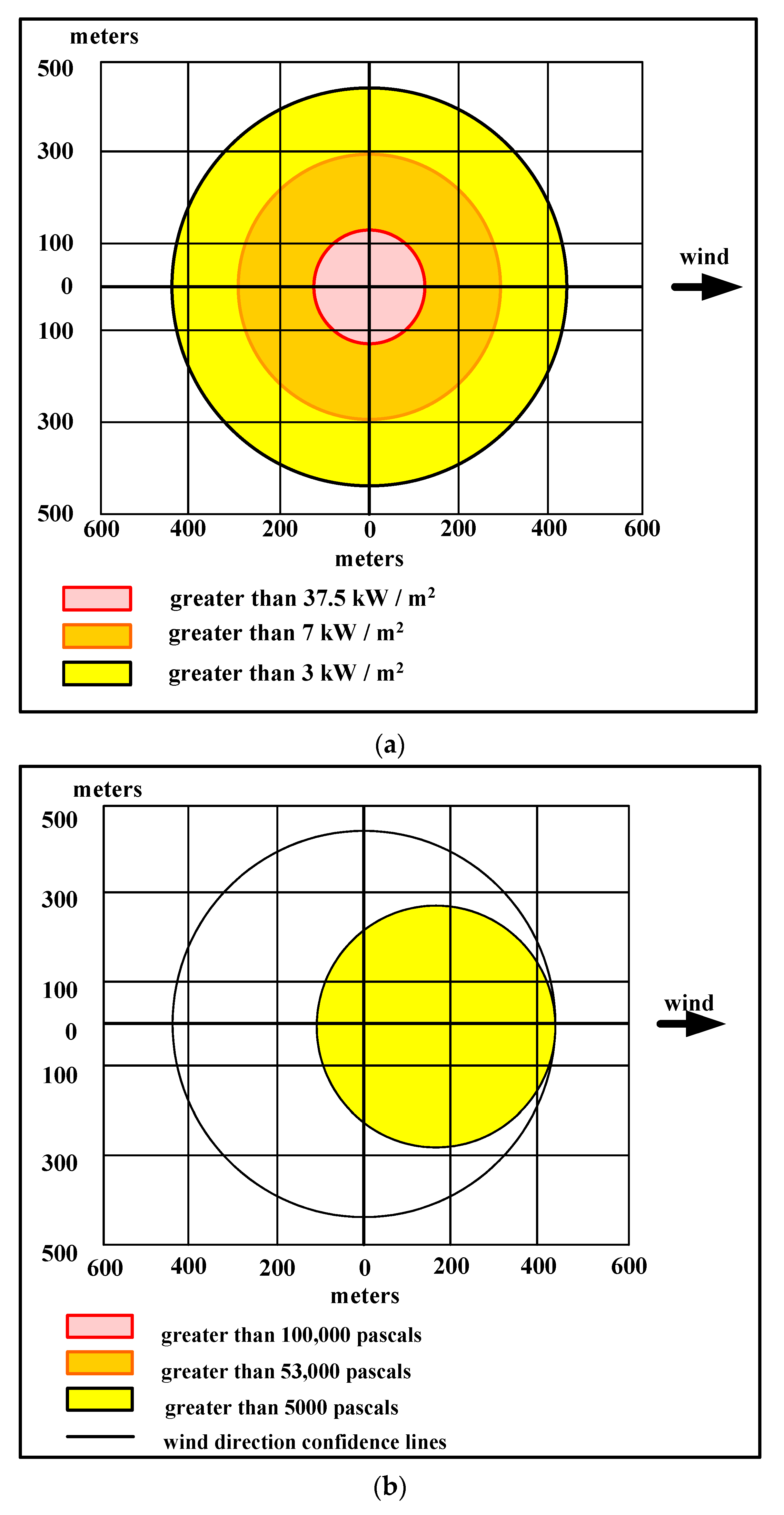
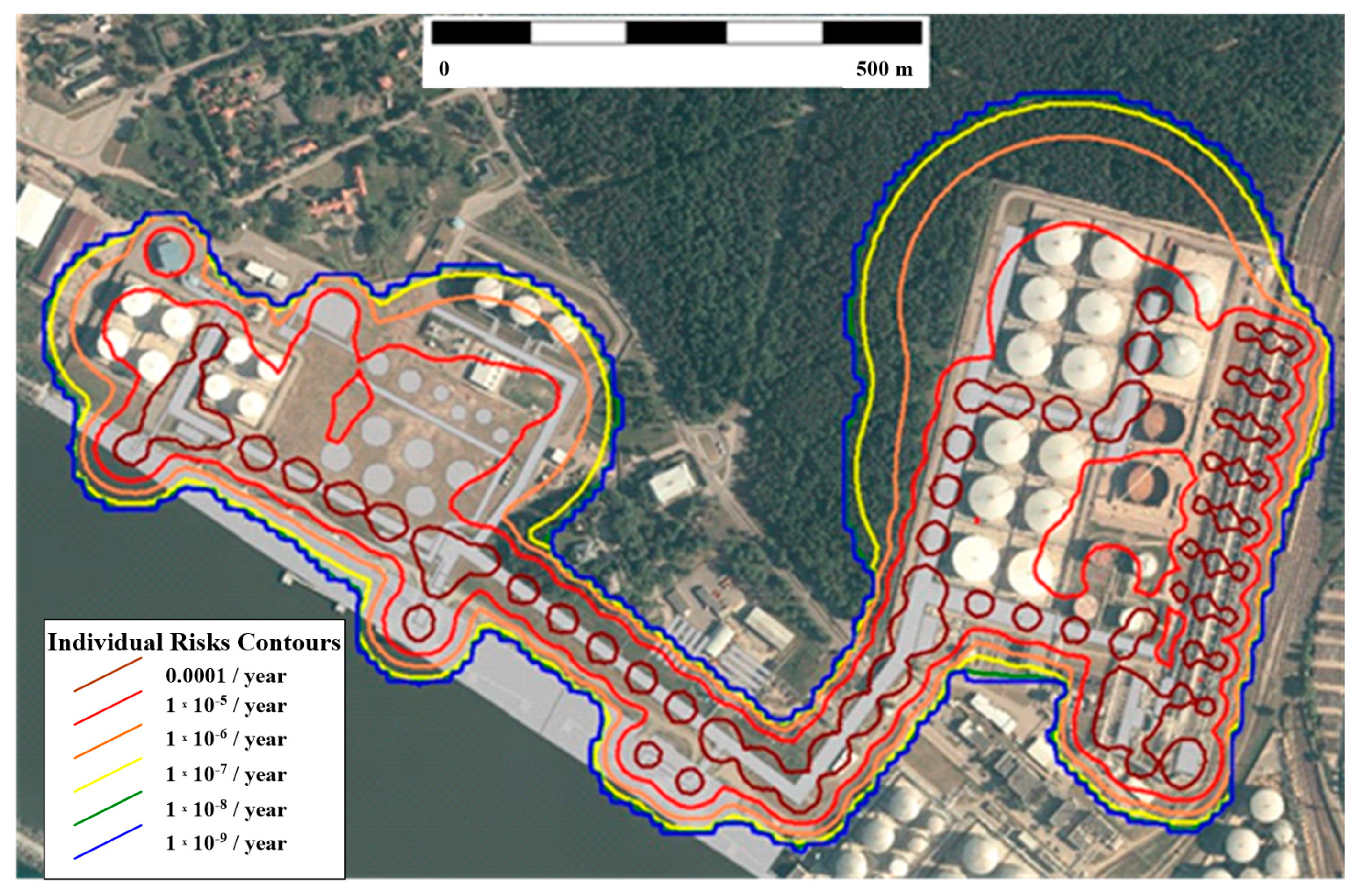
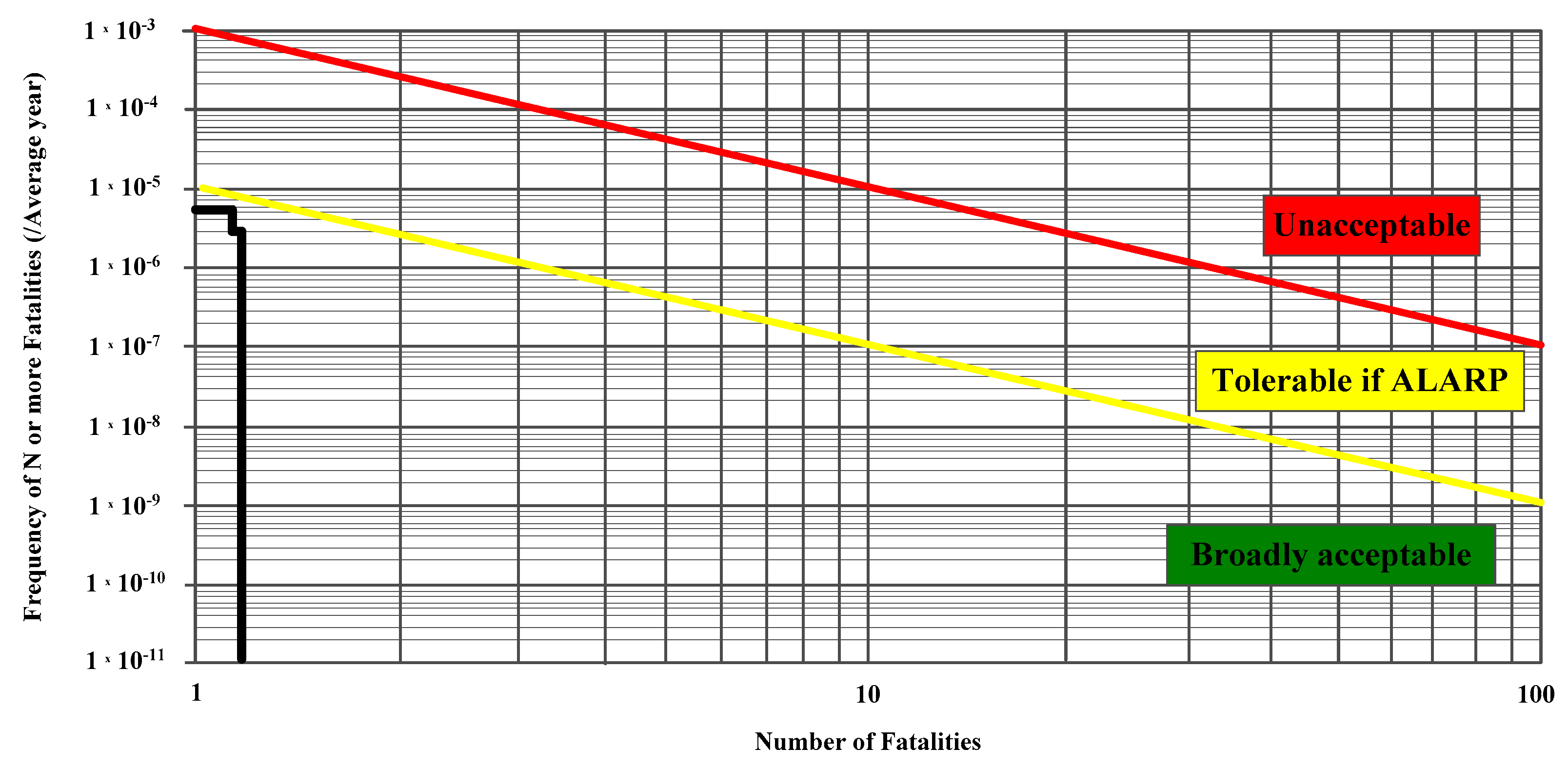
| Use of Territory | IRPA Indicator Values | ||
|---|---|---|---|
| Acceptable | ALARP Zone | Unacceptable | |
| Industrial areas | <1 × 10−6 | [1 × 10−6; 1 × 10−3] | >1 × 10−3 |
| Residential areas (rarely populated; recreational areas) | <1 × 10−6 | [1 × 10−6; 1 × 10−3] | >1 × 10−3 |
| Sensitive areas (densely populated; schools, hospitals, etc.) | <1 × 10−7 | [1 × 10−7; 1 × 10−4] | >1 × 10−4 |
| Name | LSIR Criteria |
|---|---|
| Limit of risk unacceptable to the public | 1 × 10−4 |
| Degree of risk for industrial areas (generally acceptable) | 1 × 10−5 |
| Degree of risk for residential areas (generally acceptable for living buildings) | 1 × 10−6 |
| Degree of risk for sensitive areas (acceptable for schools, hospitals, etc.) | 1 × 10−7 |
| IRPA Indicator Values | ||||||
|---|---|---|---|---|---|---|
| A | B | C | D | E | ||
| Consequences | 1 | 1 (H) | 2 (H) | 4 (H) | 7 (M) | 11 (M) |
| 2 | 3 (H) | 5 (H) | 8 (M) | 12 (M) | 16 (L) | |
| 3 | 6 (H) | 9 (M) | 13 (M) | 17 (L) | 20 (L) | |
| 4 | 10 (M) | 14 (M) | 18 (L) | 21 (L) | 23 (L) | |
| 5 | 15 (M) | 19 (L) | 22 (L) | 24 (L) | 25 (L) | |
| Risk | Risk Level Definition | Description of Relevant Actions |
|---|---|---|
| (L) | Low risk | No solutions and actions are needed due to generally acceptable risk |
| (M) | Medium risk | There is possibly a need for solutions/actions to decrease the risk while it is managed to be as low as reasonably practicable (ALARP) |
| (H) | High (intolerable) risk | There is a strict requirement to decrease the intolerable risk using the new solutions/actions and considering the ALARP principle |
| Area of KN Oil Terminal | Event | Scenarios of Possible Consequences |
|---|---|---|
| Quay Unloading sleeve Loading hoses Quay pipelines and equipment | Leakage and rupture | Fire flash Pool fire/jet fire Flammable vapor cloud fire Rapid phase transition |
| Transfer pipelines to the storage site Pipelines | Leakage and rupture | Fire flash Pool fire/jet fire Flammable vapor cloud fire |
| Area of storage tanks: pipelines of storage tanks | Leakage | Fire flash Pool fire/jet fire Flammable vapor cloud fire |
| Area of storage tanks: storage tanks | Leakage and rupture | Fire flash Pool fire/jet fire Flammable vapor cloud fire Fireball |
| Technological process zone (pumps, rectifier, and evaporators) | Leakage and rupture | Fire flash Pool fire/jet fire Flammable vapor cloud fire |
| Technological process zone (the compressors) | Leakage and rupture | Fire flash Pool fire/jet fire Flammable vapor cloud fire Fireball |
| Tank truck loading: loading sleeve, pipelines, and equipment | Leakage and rupture | Fire flash Pool fire/jet fire Flammable vapor cloud fire |
| Tank truck loading: tank trucks collision | Rupture | Fireball |
| Accident | Description of Consequences |
|---|---|
| Gas–air mixture explosions | The zone of the irreversible effect on health (ΔP > 5 kPa) reaches 755 m (Scenario *). In other scenarios, the irreversible effect on health is possible at a distance of 145–420 m. In open spaces, the amount of explosive mixture achieves higher values only above the surface of the leakage. |
| Pool fire in the case of oil leakage | The maximum impact is possible in the case of Scenario **. The minimum impact zone (q > 3 kW/m2) is 755 m, the zone of the irreversible effect to health (q > 5 kW/m2) is 592 m, possible individual fatal cases (q > 7 kW/m2) is at 504 m, and 100% mortality q > 37.5 kW/m2) is at 209 m. The minimum impact zone for gasoline fire (q > 3 kW/m2) is 160–607 m, the zone of the irreversible effect to health (q > 5 kW/m2) is 124–477 m, possible individual fatal cases (q > 7 kW/m2)is at 104–406 m, and 100% mortality (q > 37.5 kW/m2) is at 38–173 m |
| Accident | Description of Consequences |
|---|---|
| Explosion | Cascading accidents are possible at distances with excess pressure > 53 kPa. The consequences, in this case, are the destruction of buildings, serious damage to pressure tanks, and pipelines by Lithuanian regulations for the prevention, elimination, and investigation of industrial accidents. The modeling results reveal that such overpressure is not achievable in open spaces. |
| Surface fire | In the methodology in [37] and in other sources [38,39], it is accepted that partial or total damage of technical equipment at thermal radiation intensity exceeding 37.5 kW/m2 is highly probable, while the total damage of equipment is possible at around 100 kW/m2 and the deformation is at 25 kW/m2. In all cases, the impact should last for at least 15–20 min. In this study case, the cascading accidents are possible from 38 m (Scenario *) up to 173 m (Scenario **) or 209 m (Scenario ***) at distances with thermal radiation of >37.5 kW/m2. |
| Jet fire | The thermal radiation at a gas leakage and fire from the pressure system is not high. Cascading accidents are possible only if the torch flame contacts with the equipment and a thermal radiation of >37.5 kW/m2 was achieved during the long-term jet fire. At the leakage of gas from pressure systems, cascading accidents are possible at 180 m. |
Publisher’s Note: MDPI stays neutral with regard to jurisdictional claims in published maps and institutional affiliations. |
© 2021 by the authors. Licensee MDPI, Basel, Switzerland. This article is an open access article distributed under the terms and conditions of the Creative Commons Attribution (CC BY) license (https://creativecommons.org/licenses/by/4.0/).
Share and Cite
Alzbutas, R.; Vaisnoras, M.; Saruniene, I.; Krikstolaitis, R.; Valincius, M.; Babilas, E.; Augutis, J.; Rimkevicius, S.; Iesmantas, T.; Anusauskas, F.; et al. Aggregated Risk Assessment and Survey for Risk Reduction in Oil Terminals. Sustainability 2021, 13, 12169. https://doi.org/10.3390/su132112169
Alzbutas R, Vaisnoras M, Saruniene I, Krikstolaitis R, Valincius M, Babilas E, Augutis J, Rimkevicius S, Iesmantas T, Anusauskas F, et al. Aggregated Risk Assessment and Survey for Risk Reduction in Oil Terminals. Sustainability. 2021; 13(21):12169. https://doi.org/10.3390/su132112169
Chicago/Turabian StyleAlzbutas, Robertas, Mindaugas Vaisnoras, Inga Saruniene, Ricardas Krikstolaitis, Mindaugas Valincius, Egidijus Babilas, Juozas Augutis, Sigitas Rimkevicius, Tomas Iesmantas, Feliksas Anusauskas, and et al. 2021. "Aggregated Risk Assessment and Survey for Risk Reduction in Oil Terminals" Sustainability 13, no. 21: 12169. https://doi.org/10.3390/su132112169
APA StyleAlzbutas, R., Vaisnoras, M., Saruniene, I., Krikstolaitis, R., Valincius, M., Babilas, E., Augutis, J., Rimkevicius, S., Iesmantas, T., Anusauskas, F., & Mataitis, L. (2021). Aggregated Risk Assessment and Survey for Risk Reduction in Oil Terminals. Sustainability, 13(21), 12169. https://doi.org/10.3390/su132112169







